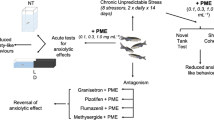Abstract
A number of studies confirmed the involvement of transient receptor potential vanilloid (TRPV) and acid-sensing (ASIC) ion channels in the physiological processes associated with the development of anxiety disorders. This makes their ligands new potential anxiolytic agents. We examined the efficacy of two peptides from the sea anemone Heteractis crispa, Hcr 1b-2 and HCRG21, affecting ASIC1a and TRPV1 channels, respectively, in the open field and elevated plus maze tests. According to the obtained data, HCRG21 significantly decreases both the level of anxiety and stimulates the activity of animals at doses of 0.01–1 mg/kg, whereas Hcr 1b-2 has a weak anxiolytic effect only at a dose of 0.1 mg/kg. The pharmacodynamic study showed that the HCRG21 has an anxiolytic effect for 2 h, and its effectiveness is higher than that of the reference drug.






Similar content being viewed by others
REFERENCES
Bandelow, B., Michaelis, S., and Wedekind, D., Treatment of anxiety disorders, Dialogues Clin. Neurosci., 2017, vol. 19, no. 2, pp. 93–107.
Wittchen, H.-U., Generalized anxiety disorder: prevalence, burden, and cost to society, Depress. Anxiety, 2002, vol. 16, no. 4, pp. 162–171.
Coryell, M.W., Wunsch, A.M., Haenfler, J.M., et al., Acid-sensing ion channel-1a in the amygdala, a novel therapeutic target in depression-related behavior, J. Neurosci., 2009, vol. 29, no. 17, pp. 5381–5388.
Sluka, K.A., Winter, O.C., and Wemmie, J.A., Acid-sensing ion channels: a new target for pain and cns diseases, Curr. Opin. Drug Discov. Dev., 2009, vol. 12, no. 5, pp. 693–704.
Aguiar, D.C., Terzian, A.L.B., Guimaraes, F.S., et al., Anxiolytic-like effects induced by blockade of transient receptor potential vanilloid type 1 (TRPV1) channels in the medial prefrontal cortex of rats, Psychopharmacology (Berlin), 2009, vol. 205, no. 2, pp. 217–225.
Escelsior, A., Sterlini, B., Murri, M.B., et al., Transient receptor potential vanilloid 1 antagonism in neuroinflammation, neuroprotection and epigenetic regulation: potential therapeutic implications for severe psychiatric disorders treatment, Psychiatr. Genet., 2020, vol. 30, no. 2, pp. 39–48.
Grueter, B.A., Brasnjo, G., and Malenka, R.C., Postsynaptic TRPV1 triggers cell type-specific long-term depression in the nucleus accumbens, Nat. Neurosci., 2010, vol. 13, no. 12, pp. 1519–1526.
Zador, F. and Wollemann, M., Receptome: interactions between three pain-related receptors or the “triumvirate” of cannabinoid, opioid and TRPV1 receptors, Pharmacol. Res., 2015, vol. 102, pp. 254–263.
Naziroglu, M. and Demirdas, A., Psychiatric disorders and TRP channels: focus on psychotropic drugs, Curr. Neuropharmacol., 2015, vol. 13, no. 2, pp. 248–257.
Quagliato, L.A. and Nardi, A.E., The role of convergent ion channel pathways in microglial phenotypes: a systematic review of the implications for neurological and psychiatric disorders, Transl. Psychiatry, 2018, vol. 8, p. 259.
Ziemann, A.E., Allen, J.E., Dahdaleh, N.S., et al., The amygdala is a chemosensor that detects carbon dioxide and acidosis to elicit fear behavior, Cell, 2009, vol. 139, no. 5, pp. 1012–1021.
Coryell, M.W., Ziemann, A.E., Westmoreland, P.J., et al., Targeting ASIC1a reduces innate fear and alters neuronal activity in the fear circuit, Biol. Psychiatry, 2007, vol. 62, no. 10, pp. 1140–1148.
Wemmie, J.A., Coryell, M.W., Askwith, C.C., et al., Overexpression of acid-sensing ion channel 1a in transgenic mice increases acquired fear-related behavior, Proc. Natl. Acad. Sci. U. S. A., 2004, vol. 101, no. 10, pp. 3621–3626.
Monastyrnaya, M., Peigneur, S., Zelepuga, E., et al., Kunitz-type peptide HCRG21 from the sea anemone Heteractis crispa is a full antagonist of the TRPV1 receptor, Mar. Drugs, 2016, vol. 14, no. 12, p. 229.
Kalina, R., Gladkikh, I., Dmitrenok, P., Chernikov, O., Koshelev, S., Kvetkina, A., Kozlov, S., Kozlovskaya, E., and Monastyrnaya, M., New APETx-like peptides from sea anemone Heteractis crispa modulate ASIC1a channels, Peptides, 2018, vol. 104, pp. 41–49.
Rukovodstvo po provedeniyu doklinicheskikh issledovanii lekarstvennykh sredstv (Guidelines for Conducting Preclinical Studies of Drugs), Mironov, A.N., Ed., Moscow: Grif i K, 2013, part 1.
Pinheiro-Junior, E.L., Kalina, R., Gladkikh, I., et al., A tale of toxin promiscuity: The versatile pharmacological effects of Hcr 1b-2 sea anemone peptide on voltage-gated ion channels, Mar. Drugs, 2022, vol. 20, no. 2, p. 147.
https://www.tsbiochem.com/compound/Afobazole%20 hydrochloride. Accessed March 5, 2022.
Tishkina, A.O., Mart’yanova, E.K., Logashina, Yu.A., et al., Effects of intranasal administration of the peptide antagonist of type I vaniloid receptor (TRPV1) in the rodent central nervous system, Dokl. Biol. Sci., 2016, vol. 470, pp. 234–236.
Kasckow, J.W., Mulchahey, J.J., and Geracioti, T.D., Effects of the vanilloid agonist olvanil and antagonist capsazepine on rat behavior, Prog. Neuro-Psychopharmacol. Biol. Psychiatry, 2004, vol. 28, no. 1, pp. 291–295.
Hayase, T., Differential effects of TRPV1 receptor ligands against nicotine-induced depression-like behaviors, BMC Pharmacol., 2011, vol. 11, no. 1, p. 6.
ACKNOWLEDGMENTS
We are grateful to R.S. Popov, Cand. Sci. (Chem.), for obtaining a high-resolution mass spectrum. The equipment of The Far Eastern Center for Structural Molecular Research (NMR/MS) PIBOC FEB RAS was used in the work.
Funding
Obtaining and studying the anxiolytic effect and pharmacodynamics of the HCRG21 peptide were supported by the Russian Science Foundation, project no. 19-74-20088, https://rscf.ru/project/19-74-20088/. The isolation of the Hcr 1b-2 peptide and the study of its effect on the level of anxiety in mice was supported by the Russian Science Foundation, project no. 22-24-00912, https://rscf.ru/project/22-24-00912/.
Author information
Authors and Affiliations
Corresponding author
Ethics declarations
Conflict of interest. The authors declare that they have no conflicts of interest.
Statement on the welfare of animals. All experimental procedures were approved by the Commission for Control over Keeping and Use of Laboratory Animals of the Shemyakin–Ovchinnikov Institute of Bioorganic Chemistry, Pushchino Branch, Russian Academy of Sciences.
Additional information
Translated by M. Batrukova
Rights and permissions
About this article
Cite this article
Sintsova, O.V., Kalina, R.S., Gladkikh, I.N. et al. Anxiolytic Effect of Peptides from Sea Anemone Heteractis crispa, Modulators of TRPV1 and ASIC Channels. Dokl Biochem Biophys 505, 145–150 (2022). https://doi.org/10.1134/S1607672922040093
Received:
Revised:
Accepted:
Published:
Issue Date:
DOI: https://doi.org/10.1134/S1607672922040093




